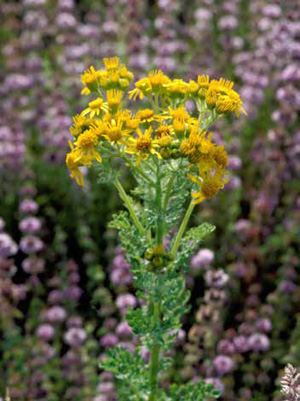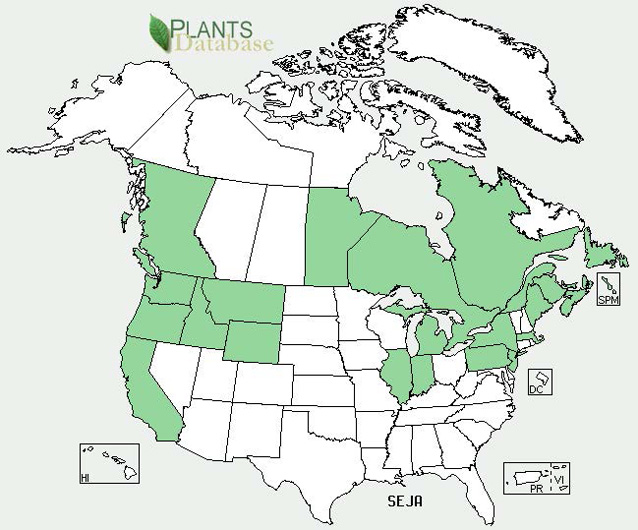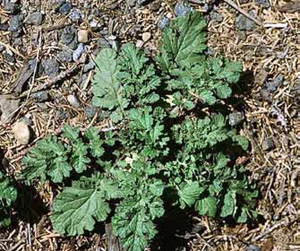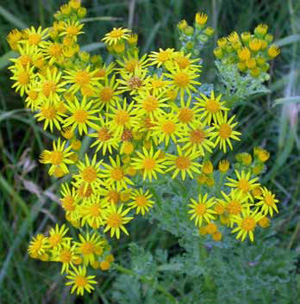Asteraceae (Sunflower family)
At a Glance

John M. Randall / The Nature Conservancy
- Biennial, perennial, and winter annual
- Flowering stems grow 8 to 36 inches tall.
- Leaves are alternate and are deeply divided into irregular segments.
- Yellow flowerheads are daisy-like and occur in clusters of 20 to 60.
- Fruit is an achene that is shaped like an cylinder.
Habitat and Ecology
Native to Europe and western Asia, tansy ragwort (Senecio jacobaea) now occurs in portions of the West, Midwest, and Northwest United States. Tansy ragwort was first reported in North America in British Columbia in 1913. Tansy ragwort grows best in cool, moist climates, on light, well-drained soils. It seldom tolerates high water tables or acidic soils. It usually invades pastures, rangelands, and sites near riparian and forested areas. The plants contain pyrrolizidine alkaloids, which are toxic to humans and livestock when ingested. Populations of tansy ragwort have been dramatically reduced through releases of ragwort flea beetle (Longitarsus jacobaeae) and cinnabar moth (Tyria jacobaeae).

USDA
Description

Joseph M. DiTomaso / UC Davis
Tansy ragwort is a biennial, perennial, or winter annual herb. Typically, it remains a rosette the first year of growth, bolting into a single flowering stalk in the second year to flower, fruit, and die. The rigid flowering stems branch near the top and usually grow 8 to 36 inches tall. Tansy ragwort has a short taproot that produces many spreading, fleshy roots. The roots and crown readily develop new shoot and root buds after injury. Root fragments can also produce new shoots. Besides reproducing vegetatively, tansy ragwort also reproduces by seed. The seeds, which can remain viable in the soil for about six years, disperse via wind, water, machinery, animals, shoes, and clothing.
Leaves
The basal rosette leaves are dark green with purplish stems and are ruffled or lobed. The stem leaves are deeply divided into irregular segments, giving the plant a ragged appearance. The younger leaves may be lightly covered with cottony hairs, especially along the midveins and lower surfaces. While the leaves towards the bottom of the stem may have short stalks, the upper leaves are smaller and attach directly to the stem. The stem leaves are alternate and two to eight inches long.

Michael Shephard / USDA Forest Service
Flowers and Fruits
The yellow flowerheads are daisy-like with light brown centers. Each flowerhead has many disc florets, which make up the center, and 13 ray florets, which make up the yellow petals along the outside. Under each flowerhead are 13 black-tipped bracts. 20 to 60 flowerheads occur into dense, flat-topped clusters at the ends of the branches. Tansy ragwort flowers July through September.
The fruit is an achene (a dry fruit with a single seed and thin walls that does not open at maturity; for example, a sunflower “seed”). The achenes, which have shallow ribs, are shaped like cylinders. Both the disc florets and the ray florets produce achenes with a ring of soft white bristles capping one of the ends. However, the disc achenes retain these bristles and are otherwise hairless, while the ray achenes shed their bristles early in fruit development and have soft hair along the ribs.
Etymology
Sene’cio comes from senex, meaning “old man”. It refers to the white bristles on the seeds.
Control Methods
Possible control methods are explained in most of the links listed in the references.
References
California Department of Food and Agriculture. No date. Senecio genus in Encycloweedia. Available at https://www.cdfa.ca.gov/plant/ipc/encycloweedia/weedinfo/senecio.htm (accessed 13 April 2010).
Charters, M. L. 2009. California plant names: Latin and Greek meanings and derivations. Available at http://www.calflora.net/botanicalnames (accessed 13 April 2010).
Drewitz, J. 2000. Senecio jacobaea in Bossard, C. C., J. M. Randall, and M. C. Hoshovsky, editors. Invasive plants of California’s wildlands. University of California Press, Berkeley, CA. Available at http://www.cal-ipc.org/ip/management/ipcw/pages/detailreport.cfm@usernumber=74&surveynumber=182.php (accessed 13 April 2010).
Jacobs, J., and S. Sing. 2009. Ecology and management of tansy ragwort (Senecio jacobaea L.). Invasive Species Technical Note No. MT-24. United States Department of Agriculture, Natural Resources Conservation Service, Bozeman, MT.
King County Department of Natural Resources and Parks. 2006. Best management practices, tansy ragwort – Senecio jacobaea. Noxious Weed Control Program, Seattle, WA. Available at http://your.kingcounty.gov/dnrp/library/water-and-land/weeds/BMPs/tansy_ragwort-control.pdf (accessed 13 April 2010).
Macdonald, C., and M. J. Russo. 1989. Senecio jacobaea in Element Stewardship Abstracts. The Nature Conservancy, Arlington, VA.
Prepared by Kelly Reeves, Southern Colorado Plateau Network Inventory and Monitoring Program, 2010.
Last updated: June 28, 2016
